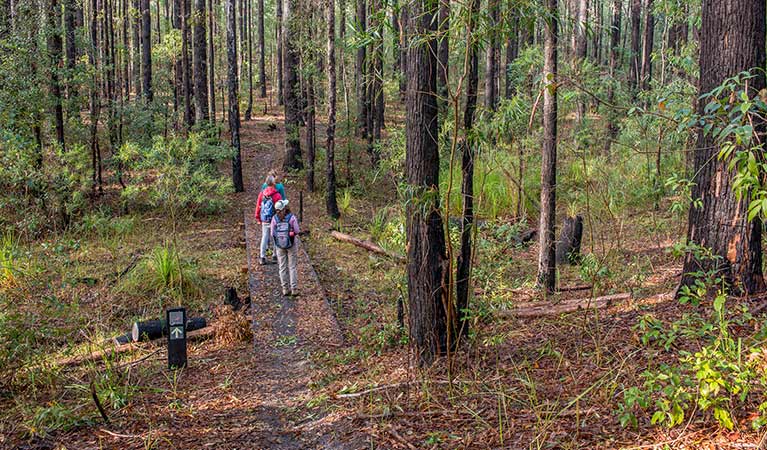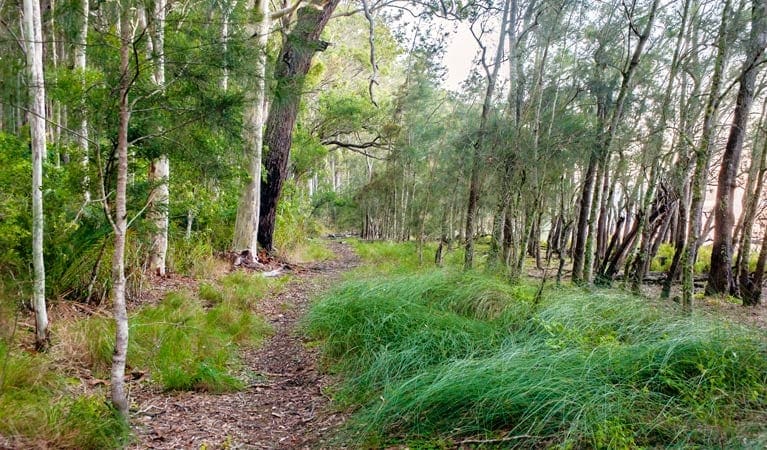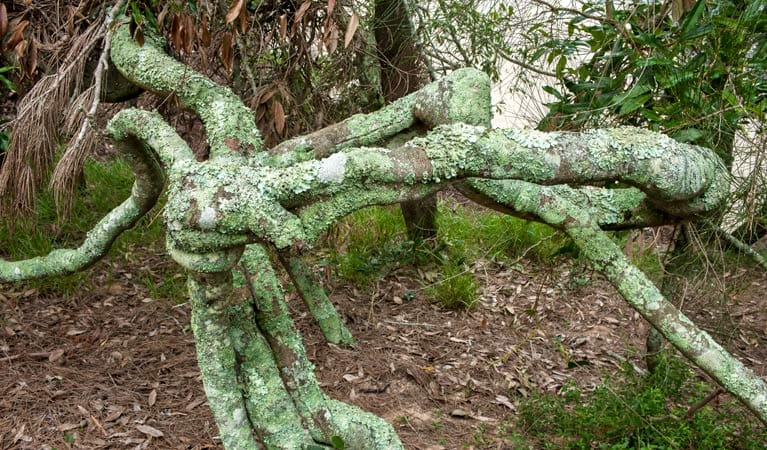Hike at a Glance
Max elevation: 0m
Min elevation: 0m
Total Ascent: 0m
Hike overview
Pot Holes walking track offers outstanding scenic views and is a perfect spot for a picnic, making it ideal for a day trip from Ulladulla or Batemans Bay. This 3 km, grade 3 hike in Meroo National Park, New South Wales, typically takes about 1.25 hours to complete. The track winds through stunted heathland, leading to unspoilt coastline with picturesque picnic spots along the way.
It’s a popular choice among locals for an early morning walk or as a route to Pot Holes Beach for surfing. You can also bring your fishing gear to try your luck or enjoy swimming in the pristine waters. In spring, the heathland comes alive with the vibrant colours of wildflowers like common fringe lily, orchids, and grevillea. Winter is equally enchanting when the banksias bloom, attracting honeyeaters and offering excellent birdwatching opportunities. Additionally, this spot is known for its whale-watching potential, adding to its year-round appeal.
Gallery
Got some great shots from this hike? Upload your photos here to inspire others and show off the beauty of the trail!
Click to view form >>
Submitting your photos doesn’t mean you lose ownership. You can be credited for your contributions, and you can request removal at any time.
Content use
Please don’t copy GPX files or content from this site to AllTrails or other platforms. Each trail has been personally mapped, documented, and refined to support Australia’s bushwalking and hiking community. While some details come from land managers, every listing reflects significant personal effort. This is a free, community-driven initiative—your respect helps keep it that way.
Walk map and GPX file
It looks like I don’t have a GPX file for this trail yet. If you have one to share, please email it to me! I’ll verify it against official maps before adding it to help other hikers have a safer, easier experience. Thanks for contributing to a better hiking resource.
Getting there
Getting to the trailhead: Meroo National Park.
To reach the trailhead for Pot Holes walking track, head to the Lagoon Head precinct in the northern part of Meroo National Park. If you’re traveling from Ulladulla, take the Princes Highway south. About 2 km after passing through Burrill Lake township, turn east onto Pot Holes Road and follow it until you reach the carpark at the end, where the walking track begins.
Alternatively, you can turn left onto Dolphin Point Road at Burrill Lake township, then continue as it becomes Highview Drive. Follow Highview Drive to its end, where another access point to the walking track is located. Be mindful of road conditions, as the route can become boggy in wet weather. Parking is available either at the Pot Holes carpark or at the end of Highview Drive, Dolphin Point.
Closest towns to this walk: Adaminaby, Batemans Bay, Bawley Point, Berridale, Berry, Bomaderry, Cooma, Jindabyne, Kangaroo Valley, Meroo, Meroo Meadow, Milton, Moruya, Nelligen, Nowra, Termeil, Ulladulla
About the region
Discover Meroo National Park, a pristine coastal sanctuary nestled between Ulladulla and Batemans Bay on the New South Wales South Coast. This idyllic park offers a wealth of experiences for visitors of all ages and interests. Immerse yourself in nature as you explore the park's diverse landscapes. Enjoy fishing, swimming, walking, bushwalking, hiking, and cycling amidst stunning coastal scenery. For those seeking tranquillity, the park's peaceful lakes provide opportunities for kayaking and birdwatching.
Meroo National Park is also a haven for camping enthusiasts. Pitch your tent at Meroo Head campground and wake up to the sound of waves crashing on the shore. This beachfront location offers easy access to swimming, snorkelling, surfing, and fishing, as well as breathtaking views. Whether you're planning a family getaway, a romantic escape, or a solo adventure, Meroo National Park promises an unforgettable experience.
Similar walks nearby
Looking for more walks in or near Meroo National Park? Try these trails with a similar difficulty grade.
Track grade
Grade 3 (Moderate) - Walks for Most Fitness Levels: Grade 3 on the AWTGS represents moderate walking tracks. These are ideal for walkers with some fitness who are comfortable with some hills and uneven terrain. While suitable for most ages, some bushwalking experience is recommended to ensure a safe and enjoyable experience. Tracks may have short, steep hill sections, a rough surface, and many steps. The total distance of a Grade 3 walk can be up to 20 kilometers.
Explore safe
Plan ahead and hike safely! Carry enough water, pack layers for changing conditions, and bring safety gear like a torch, PLB, and reliable communication device. Check official sources for trail updates, closures, and access requirements, and review local weather and bushfire advice. Most importantly, share your plans with someone before you go. Being prepared makes for a safer and more enjoyable hike! Stay Safe, Explore More, and Always #ExploreSafe.
Packing checklists
What you carry in your pack depends on factors like weather, terrain, and your adventure type. Not sure what to bring? My free planning, food, and packing checklists are a great starting point, covering day hikes, overnight trips, and multi-day adventures. Use them to customise your kit and always prioritise safety.
Let someone know
Before heading out, take a moment to fill out your trip intentions form. It’s a quick way to share your hike details with family or friends. If something goes wrong, they can notify emergency services, ensuring a faster response and peace of mind. Stay safe and enjoy your adventure
Suggest an edit
Spotted a change on this trail? Maybe there are new features, the route has shifted, or the trail is permanently closed. Whatever the update, I’d love your input. Your feedback helps fellow hikers stay informed and ensures that our trail info stays fresh and reliable.
Acknowledgement of Country
Trail Hiking Australia acknowledges the Traditional Owners of the lands on which we hike and pay respects to their Elders, past and present, and we acknowledge the First Nations people of other communities who may be here today.






